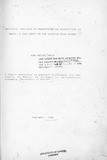| dc.description.abstract | This study is concerned with marketed milk going through the official channel in Kenya during the period between 1957 and 1985. The objectives of the study were to:
1. Study the supply pattern of commercial milk production; and
2. Determine the duration between one period of both milk surplus and deficit and another.
3. Determine the significant factor's influencing the magnitude of marketed milk product ion.
Graphical and regression methods are used in analysing the time series data on marketed milk product ion.
Results of graphical analysis indicate that during the period when the quota and contract pricing system was operating, i.e. 1957 to 1971, there was a stable and predictable pattern of marketed milk production.
However, there are marked fluctuations in the level and pattern of marketed milk production during the current uniform pricing system.
The results indicate that there is a 4.59 to 4.95 year cycle between any two different periods, each of which is composed of milk surplus and deficit. It is determined at 4.77 + 0.18 years.
The results of regression analysis indicate that previous levels of marketed milk production, technology, method of producer pricing and weather are, at 95 percent confidence interval, significant as the factors influencing the magnitude of commercial milk production in Kenya. Previous surplus appears to have a negative influence on subsequent levels of marketed milk production. Technology has an overall upward influence on marketed milk production. The quota and contract pricing system appears to have had a negative influence on commercial milk production.
The weather has a directly corresponding influence on marketed milk production.
The implications of the results relate to stabilizing the level and pattern of commercial milk production through price adjustments. It is suggested that future producer prices be regulated through adoption of quantity premiums. This may encourage
more efficient milk collection systems. Furthermore,
strategic use of various livestock feeds is suggested especially in the dry season to help stabilize
the observed seasonal and cyclic fluctuations in the magnitude of commercial milk production. | en_US |



